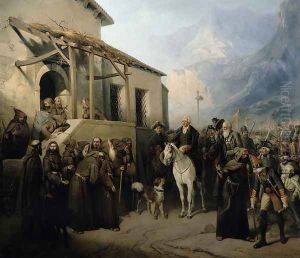Adolf Jossifowitsch Charlemagne Paintings
Adolf Jossifowitsch Charlemagne, born on March 18, 1826, in St. Petersburg, Russia, was an artist of French-Huguenot and Russian descent, known for his significant contributions to Russian numismatics, graphic design, and painting. His artistic journey began under the guidance of his father, Joseph Charlemagne, who was also a notable architect and graphic artist. Adolf received an education at the Imperial Academy of Arts in St. Petersburg, where he honed his skills in graphic art and design.
During his career, Charlemagne became a prominent figure in Russian numismatics. He was appointed as the chief medal artist at the Saint Petersburg Mint, where he designed numerous coins and medals that became official currency in the Russian Empire. His designs often featured intricate details and portraiture, showcasing his skill in capturing likeness and decorative elements.
In addition to his numismatic work, Charlemagne was a prolific graphic artist. He contributed to the design of banknotes, bonds, and various state documents. His work extended to creating illustrations for books, magazines, and other publications, where his engravings and lithographs received considerable recognition.
Charlemagne's artistic talents were not limited to graphic arts; he was also a painter, although this aspect of his work is less documented and celebrated than his graphic and numismatic achievements. Throughout his life, he was a respected member of the artistic community in Russia and was awarded several honors for his contributions to Russian art and design.
Adolf Jossifowitsch Charlemagne passed away on February 24, 1901, in St. Petersburg. His legacy lives on through his artistic contributions, particularly in the field of numismatics, where his coin and medal designs are still appreciated by collectors and historians alike.


